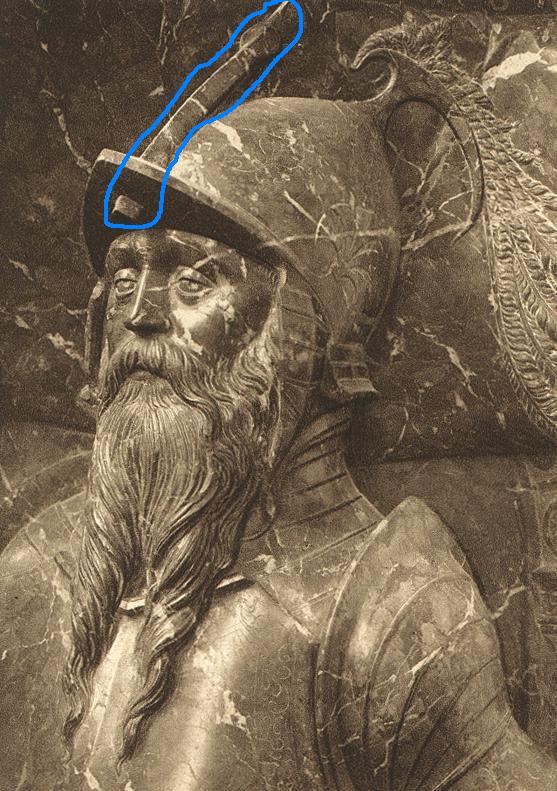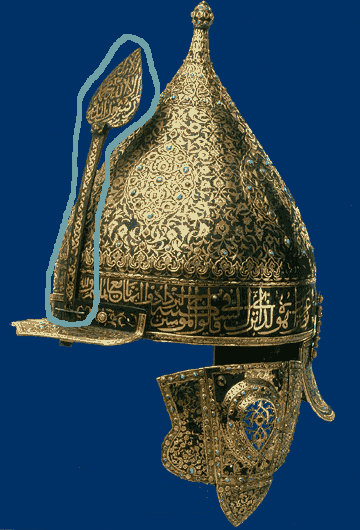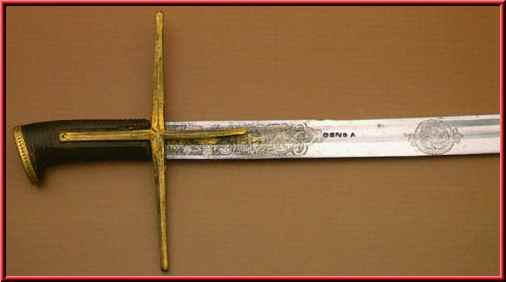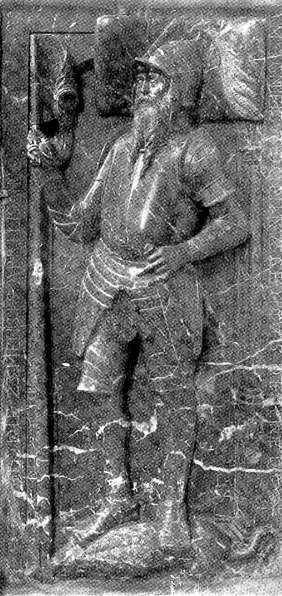| Author |
Message |
|
Samuel Bena
Location: Slovakia Joined: 10 Dec 2007
Posts: 94
|
 Posted: Thu 09 Jul, 2009 9:56 am Post subject: Helmet identification Posted: Thu 09 Jul, 2009 9:56 am Post subject: Helmet identification |
 |
|
Hi !
This picture is from a Marble monument to György Serédy (1549) located in St Egidius Church in Bardejov, Slovakia(which was a part of kingdom of hungary in the middleages/renaisance).
http://www.hung-art.hu/kep/zmisc/faragvan/163_sz/seredy.jpg
Is the helmet worn by the man of the çiçak/sishak/Zischagge type? thanks
|
|
   |
 |
Sean Flynt

|
|
   |
 |
|
Samuel Bena
Location: Slovakia Joined: 10 Dec 2007
Posts: 94
|
 Posted: Sat 11 Jul, 2009 7:29 am Post subject: Posted: Sat 11 Jul, 2009 7:29 am Post subject: |
 |
|
| Sean Flynt wrote: | | Not quite a fully-developed Zischagge, but an ancestor of that type. In more general terms, it's a burgonet. |
Thanks for clarification and that splendid article of yours  . Personally I find this one http://www.myArmoury.com/view.html?features/pic_spot_burg06.jpg to be the most similar. . Personally I find this one http://www.myArmoury.com/view.html?features/pic_spot_burg06.jpg to be the most similar.
However I am still a bit puzzled by the presence of that "nasal bar" that seems to be a feature found on the ottoman turkish helmets (I am not familiar with the terminology for that part ; I would welcome if somebody could clear it up and correct me ).
What do you think? Is it some sort of a crossbreed between west and east? Thanks
 Attachment: 109.36 KB Attachment: 109.36 KB

György Serédy
 Attachment: 37.57 KB Attachment: 37.57 KB

turkish ottoman helmet , note the "nasal bar"
|
|
   |
 |
Nathan Robinson
myArmoury Admin


|
|
    |
 |
M. Eversberg II

|
 Posted: Sat 11 Jul, 2009 11:55 pm Post subject: Posted: Sat 11 Jul, 2009 11:55 pm Post subject: |
 |
|
West meets East, form meets function, everyone profits 
As an aside; the nasals are supposed to slide up and down on those, correct?
M.
This space for rent or lease.
|
|
      |
 |
|
Samuel Bena
Location: Slovakia Joined: 10 Dec 2007
Posts: 94
|
 Posted: Sun 12 Jul, 2009 9:22 am Post subject: Posted: Sun 12 Jul, 2009 9:22 am Post subject: |
 |
|
| M. Eversberg II wrote: | West meets East, form meets function, everyone profits 
As an aside; the nasals are supposed to slide up and down on those, correct?
M. |
Yeah, that seems to be one the "features" of the ottoman type helmets.
I have seen the monument myself (sadly havent got a camera to take pics , I happened to be there by pure chance anyway). What's interesting is that there is another similar monument just a couple of steps away in an adjacent "alley" ( its in a church) depicting an anonymus nobleman/knight from early 16th century that is rumored to have been slain in the Battle of Mohacs (1526) against the Turks. His armament is completely in western/german fashion ("closed helmet", straight arming sword etc.). György's armament ( dated to 1549,but some historian dated it to 1557 ; so basicaly middle of the 16th century) on the other hand has this fancy "east-meets-west" burgonet and a sabre that Poles call "Batorówka " (the one with the longish crossguard , named after their transylvanian-born king Bathory elected in 1575 IIRC).
Seems like a nice showcase of transition and of ottoman/ balkan hussar pressure/borrowings. If you look closely György's body-armour is pretty much western in origin. Furthermore there was a statement made somewhere on this forum that after Mohacs the knightly class in Hungary simply vanished , but I would argue that this is not really the case. IMO They (the noblemen) simply changed some of their gear ( longer eastern lance , sabre , helmet) and accustomed its tactics to a different foe but at its core they were still the knightly- "shock"-primarily lancer cavalry ( excluding the other irregular horse and firearms that mixed up things a little in the later stages of the century , but thats for another topic).
Sorry I veered a bit off topic , I just could not hold myself back 
 Attachment: 8.14 KB Attachment: 8.14 KB

A closeup on the hilt of a "Batorowka" sabre. The type can seen on the monument.
 Attachment: 45.08 KB Attachment: 45.08 KB

Full view on the marble monument (1545 or 1557) ; excuse the poor quality it is the only available pic I found
Last edited by Samuel Bena on Sun 12 Jul, 2009 11:57 am; edited 1 time in total
|
|
   |
 |
|
M. Oroszlany
Location: Czech Republic / Slovakia / Hungary Joined: 12 Jan 2009
Posts: 34
|
 Posted: Sun 12 Jul, 2009 10:57 am Post subject: Posted: Sun 12 Jul, 2009 10:57 am Post subject: |
 |
|
Hungarian weapons and armor show very much eastern influence from the beginning of the 16th century onwards. From the battle of Mohacs (1526) until the re-taking of Buda (1686) by the Holy League, Hungary was partly occupied by, and constantly fighting the ottoman empire. The knights have indeed vanished shortly after the battle of Mohacs, partly because many of the nobility have fallen there (even the king did), and partly because knightly tactics were not effective against the ottomans. Gunpowder also did its share.
The return to the (mainly) light cavalry style warfare did of course bring with itself many influences borrowed from the ottomans, as the Hungarians skipped some 500 years of development in this field.
Also a piece of trivia: the word "sisak" in Hungarian translates to "helmet" in english.
EDIT: sorry, I didn't see this
| Quote: | | As an aside; the nasals are supposed to slide up and down on those, correct? |
Yes, they are usually held in place by a screw on the forehead, as you can see in the second pic posted by Nathan.
|
|
  |
 |
|
Samuel Bena
Location: Slovakia Joined: 10 Dec 2007
Posts: 94
|
 Posted: Sun 12 Jul, 2009 11:50 am Post subject: Posted: Sun 12 Jul, 2009 11:50 am Post subject: |
 |
|
| M. Oroszlany wrote: | Hungarian weapons and armor show very much eastern influence from the beginning of the 16th century onwards. From the battle of Mohacs (1526) until the re-taking of Buda (1686) by the Holy League, Hungary was partly occupied by, and constantly fighting the ottoman empire. The knights have indeed vanished shortly after the battle of Mohacs, partly because many of the nobility have fallen there (even the king did), and partly because knightly tactics were not effective against the ottomans. Gunpowder also did its share.
The return to the (mainly) light cavalry style warfare did of course bring with itself many influences borrowed from the ottomans, as the Hungarians skipped some 500 years of development in this field.
Also a piece of trivia: the word "sisak" in Hungarian translates to "helmet" in english.
EDIT: sorry, I didn't see this
| Quote: | | As an aside; the nasals are supposed to slide up and down on those, correct? |
Yes, they are usually held in place by a screw on the forehead, as you can see in the second pic posted by Nathan. |
Hello Mr. Oroszlany
I like your contribution , but I would kindly disagree on some points 
It is not true that the whole of hungarian nobility fell at Mohacs , otherwise there would be no Royal Hungary afterwards! Next , I find the "uselessnes" of western knights agains ottoman cavalry as not really true. Remeber Janos Hunyiadi' s (as well as his son Matthias Corvinus) successes of employing western style man at arms in their campains against the Ottomans . There were only effective when properly employed (and supported by auxilliary light cavalry like hussars or nomands such as Cumanians) , heck even Pál Tomori's early pre-Mohacs skirmishes against ottomans "scored some points" (so to speak). Also hungary did not "skip 500 years of ( light cavalry i presume) evolution" . It is true that hungarian nobles themselves (after being christianized) gradually switched to knightly/shock cavalry after the establishment of hungarian kingdom in 1000 A.D. , however other semi-nomadic people were hired/epmployed as light "nomadic/mongol/bow n arrow archer" cavalry. ( Such as Pechengs, Szekeli and Cumanians, for that matter I recommend the site that I listed further down and also Vásáry' s superb book Cumans and Tatars http://www.amazon.com/Cumans-Tatars-Oriental-...amp;sr=8-1 )
Mohacs was a disaster , however it was NOT because of inferiority of individual troops (much less knights IMO) , but because of poor planning and economic crisis (After the death of Matthias in 1490 Hungary felt into deep economic and moral recession; and as if that was not enough the famous "Fekete sereg"/The elite Black Army of Corvinus era became unpaid and started robbing the countryside). There is a splendid article on that issue here http://www.hungarian-history.hu/lib/warso/
I apologize if I sound too patronizing , it was definetly not my intention ! Its only that the peroid/area is an interest of mine 
Cheers,
P.S: Nice to "see" someone from central europe , do you happen to speak Czech or Slovak , if so I would be glad to chat with you (send a PM if you do , you are welcome  ) )
|
|
   |
 |
|
M. Oroszlany
Location: Czech Republic / Slovakia / Hungary Joined: 12 Jan 2009
Posts: 34
|
 Posted: Mon 13 Jul, 2009 1:17 am Post subject: Posted: Mon 13 Jul, 2009 1:17 am Post subject: |
 |
|
Hi.
Nice to see someone versed in the history of my homeland. Most of your points are valid, however some I disagree with.
| Quote: | | It is not true that the whole of hungarian nobility fell at Mohacs , otherwise there would be no Royal Hungary afterwards! |
I didn't say the whole, I said many of them. In fact, Royal Hungary almost ceased to exist shortly after the battle of Mohacs. Cca. half the country was gradually occupied by the ottoman empire, The western part of the remaining half fell under Habsburg rule (this part was the continuation of Royal Hungary), the eastern part became the Transylvanyan Principality.
| Quote: | | Next , I find the "uselessnes" of western knights agains ottoman cavalry as not really true. |
How else do you explain then, that all through the middle ages, every 200 or so years some light cavalry based army came and ransacked Europe? The Huns (~700's), the Hungarians (900's), the Tatars (1200's) and the Ottomans (1500's). Sure, a knightly army can be used against them to good effect, but only with a decent tactical advantage to start with. Very good at defending fortresses, not so good out on the field. The eastern type army has to have restricted movement. Hunyadi's win at Beograd is a great example. They won on boats on the Danube, they repelled an attack on the walls, then they sandwiched the ottomans between the Danube, Hunyadi's men and a nearby crusading army.
To be back on topic, the skipped 500 years of evolution I meant of light cavalry armor specifically. The Pescheneg's and the Cumins were the same type of unarmoured cavalry as the Hungarians when they came to Europe. The Hungarian sabre that was in use in the 16-17th cent. for example can be traced all the way back to our nomad ancestors (they pretty much just prolonged the crossguard), but almost all the armor is of western or Ottoman origin.
|
|
  |
 |
|
Samuel Bena
Location: Slovakia Joined: 10 Dec 2007
Posts: 94
|
 Posted: Mon 13 Jul, 2009 8:56 am Post subject: Posted: Mon 13 Jul, 2009 8:56 am Post subject: |
 |
|
| M. Oroszlany wrote: | Hi.
Nice to see someone versed in the history of my homeland. Most of your points are valid, however some I disagree with.
| Quote: | | It is not true that the whole of hungarian nobility fell at Mohacs , otherwise there would be no Royal Hungary afterwards! |
I didn't say the whole, I said many of them. In fact, Royal Hungary almost ceased to exist shortly after the battle of Mohacs. Cca. half the country was gradually occupied by the ottoman empire, The western part of the remaining half fell under Habsburg rule (this part was the continuation of Royal Hungary), the eastern part became the Transylvanyan Principality.
| Quote: | | Next , I find the "uselessnes" of western knights agains ottoman cavalry as not really true. |
How else do you explain then, that all through the middle ages, every 200 or so years some light cavalry based army came and ransacked Europe? The Huns (~700's), the Hungarians (900's), the Tatars (1200's) and the Ottomans (1500's). Sure, a knightly army can be used against them to good effect, but only with a decent tactical advantage to start with. Very good at defending fortresses, not so good out on the field. The eastern type army has to have restricted movement. Hunyadi's win at Beograd is a great example. They won on boats on the Danube, they repelled an attack on the walls, then they sandwiched the ottomans between the Danube, Hunyadi's men and a nearby crusading army.
To be back on topic, the skipped 500 years of evolution I meant of light cavalry armor specifically. The Pescheneg's and the Cumins were the same type of unarmoured cavalry as the Hungarians when they came to Europe. The Hungarian sabre that was in use in the 16-17th cent. for example can be traced all the way back to our nomad ancestors (they pretty much just prolonged the crossguard), but almost all the armor is of western or Ottoman origin. |
Great points raised Michael !
However I still maintain that the men at arms were not so useless against Ottomans at all! I cant speak for the earlier era of Magyar /Hun conquest (i am not very versed in it) , but as far as the Mongol Tatars (of the 13th century) are concerned they have not beaten every "western-style" army. Make no mistake I am not underestimating Tatars , they were definetly great warriors and strategist par excellence and made quite a feat . However not every "knightly" army was "crushed" , so to speak. One example is the Czech king Wenceslaus I Premysl that has repelled them with pretty much standard western knightly cavalry. As far as hungary is concerned, king Bela made a fatal mistake in underestimating the threat of mongol danger but imho also more importantly he accused the Cumans (that had fled from the mongol advance) of being spies of the Mongols and ordered to slaughter them , thus loosing valuable allies. Also after the death of Batu khan the threat of another invasion did not diminish. The remaning Mongol horde did not vanish but continue to play a great deal of politics among the various balkan factions and was even used as a sort of "Boogeyman". Batu' s successor Nogai Khan and his horde were stationed in nearby eastern balkans and attempted another attack in 1285 together with some contingent of Cumanians but were beaten by Ladislavus IV (the infamous László Kun the cumanian  ) ,by his "royal" army (i assume that meant pretty much western knights/men at arms) and when fleeing they were ambushed by Szekeli ( source http://www.hungarian-history.hu/lib/kos/kos06.htm ). ) ,by his "royal" army (i assume that meant pretty much western knights/men at arms) and when fleeing they were ambushed by Szekeli ( source http://www.hungarian-history.hu/lib/kos/kos06.htm ).
Moving to ottomans , I do agree that because of their heavy lineage in central lance/bow-(and warhammer:) ) armed cavalry they required a different tactics , and they have indeed defeated a number of western cavalry , however it was not always the rule . For example in the 14th century Ottoman-Byzantine-Serbian battles the Turks had troubles with Serbs (Gallipoli for example where they crushed the turks) , and it was almost after a century of fighting that resulted in Kosovo defeat for the Serbs. AFAIK Serbs of the 14th century had an extensive tradition in "knightly-shock" cavalry. Whats interesting is that after Kosovo, Prince Stefan Lazarevic became Bayezid' s vassal and quite a key ally (the infamous "lame" crusade of nicopolis among other things , that might have resulted in christian victory but was sealed by Stefans charge). The story of Stefan later goes with him defeating Bayezids son Musa at The battle of Despotovac and becoming Despot of Serbia.
Another point i would like to adress was the "borrowing" from Ottomans. They (hungarians and balkan people that fought ottomans) did NOT just "copy and paste" the equipment and tactics of akinji/sipahi on their cavalry. That is the point I am arguing in this thread ; the early Rac/Serbian hussars adopted stirrups and the eastern lance (which became also somewhat longer) , but fought pretty much the same way as their knightly ancestor, albeit they were better at pursuing the "nomadic" cavalry since they dropped armour completely (with the only protection provided by the winged shield).
A splendid example of the Rac-hussars is the battle of Orsha
http://upload.wikimedia.org/wikipedia/commons...-08%29.jpg (Muscovy vs Poles) ,
the battle is from 1514 but the painting is IIRC somewhere around 1530, and that also pretty much reflects how Mohacs could looked (Niccole in his work on Russian medieval and renaissance armies mentions "Russian way of war" , consisting of suprising the westerners with eastern tactics and vice versa). Note that 90% of those Hussars (the "winged shield" , long lance , no armour, fancy headgear are lancers pretty much like the allied Polish man at arms (there is an excepton , few men in the lower-center are armed with bows , but they seem to be a rarity).
After Mohacs it seems that the remaining hungarian nobles simply adopted some of the hussar equipment (sabre , eastern lance) and partly ottoman gear (the nasal bar that i showed on the picture) , but pretty much remained shock cavalry as their knightly fathers nevertheless and not the "nomadic" type (armed with bow , kalkan shield and lance with tactics being similar to that of mongols) like the Turks. Thus I humbly disagree that Hungarians returned to the "roots" , I would argue the opposite that the "knightly" style of combat remained much longer in eastern europe , especially in Poland with its "heavy" hussars ( remember that they are based on Bathory' s men , hence hungarian ; later on the shield and lance "rac/serbian" hussar type seem to faded away and firearms mixed things up as well).
Hope I did not steer to much offtopic , I enjoy the discussion very much 
Cheers
|
|
   |
 |
|
|
You cannot post new topics in this forum
You cannot reply to topics in this forum
You cannot edit your posts in this forum
You cannot delete your posts in this forum
You cannot vote in polls in this forum
You cannot attach files in this forum
You can download files in this forum
|
All contents © Copyright 2003-2025 myArmoury.com — All rights reserved
Discussion forums powered by phpBB © The phpBB Group
Switch to the Basic Low-bandwidth Version of the forum
|

